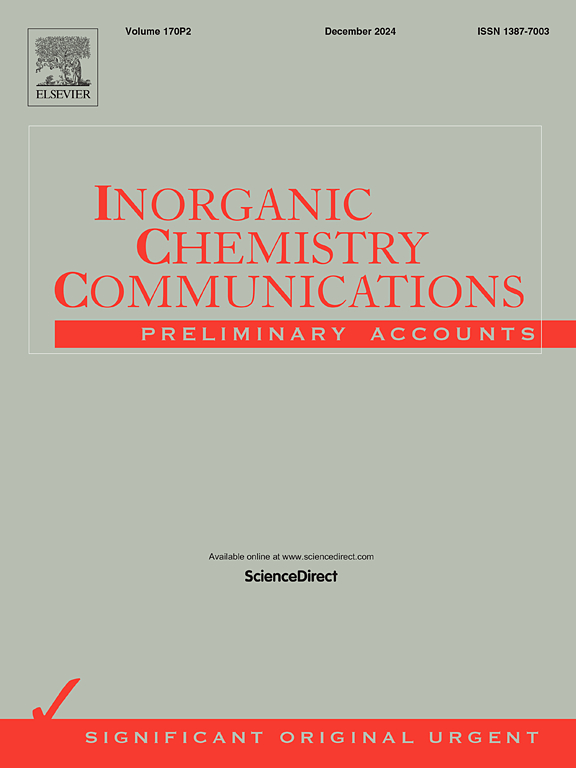Comparative transition molybdates (XMoO4 (X = Co, Mn, Ni, and Zn)) for high-performance supercapacitors
IF 4.4
3区 化学
Q1 CHEMISTRY, INORGANIC & NUCLEAR
引用次数: 0
Abstract
Owing to its exceptional rate capability, long-term stability, and quick charge–discharge capability, supercapacitors (SCs) have garnered significant interest of researchers. Practical SCs demand inexpensive and stable electrode materials. Owing to their appealing physical and chemical properties, transition metal molybdates are considered as a prospective electrode material. Herein, metal molybdate (XMoO4, X = Co, Mn, Ni, Zn) have been synthesized employing a facile sol–gel auto combustion process. X-ray powder diffractometer was employed to validate the synthesis of the nanostructures. The prepared samples surface morphological characteristics and elemental composition were examined employing an energy dispersive X-ray spectroscope combined with a scanning electron microscope. The morphologies were further investigated by transmission electron microscope. X-ray photoelectron spectroscope was employed to examine the synthesized samples for element oxidation states. The electrochemical behaviour of different samples was examined in two-electrode SC system employing electrochemical impedance spectroscopy (EIS), cyclic voltammetry (CV), and galvanostatic charge/discharge (GCD) techniques. EIS along with CV and GCD confirm the SC electrode behaviour of the synthesized materials. The impact of the inherent characteristics of electrodes on specific capacitance was examined by the comparative experimental study. Co based molybdate showed excellent specific capacitance (318.22F g−1), specific power (0.89 kW kg−1) and specific energy (11.04 Wh kg−1) at a current density of 0.5 A g−1, while the best cyclic stability (capacitance retention of about 95 % after 10,000 cycles) was displayed by Mn based molybdate. The high electrical conductivity and superior quality of the sample, that facilitates rapid ion movement and aqueous electrolyte medium interaction, may be accounted for the remarkable electrochemical performances. Overall, the observed results emphasize the significance of molybdate nanostructures as a potential electrode material for next-generation energy storage applications.

用于高性能超级电容器的比较过渡钼酸盐(XMoO4 (X = Co, Mn, Ni和Zn))
超级电容器(SC)具有超强的速率能力、长期稳定性和快速充放电能力,因此引起了研究人员的极大兴趣。实用的超级电容器需要廉价而稳定的电极材料。由于过渡金属钼酸盐具有吸引人的物理和化学特性,因此被认为是一种前景广阔的电极材料。本文采用简便的溶胶-凝胶自燃工艺合成了金属钼酸盐(XMoO4,X = Co、Mn、Ni、Zn)。采用 X 射线粉末衍射仪验证了纳米结构的合成。利用能量色散 X 射线光谱仪和扫描电子显微镜对制备的样品表面形态特征和元素组成进行了检测。透射电子显微镜对形貌进行了进一步研究。利用 X 射线光电子能谱仪检测了合成样品的元素氧化态。采用电化学阻抗谱(EIS)、循环伏安法(CV)和电静态充放电(GCD)技术,在双电极 SC 系统中检测了不同样品的电化学行为。EIS 以及 CV 和 GCD 证实了合成材料的 SC 电极特性。通过对比实验研究了电极固有特性对比值电容的影响。在电流密度为 0.5 A g-1 时,钴基钼酸盐显示出优异的比电容(318.22F g-1)、比功率(0.89 kW kg-1)和比能量(11.04 Wh kg-1),而锰基钼酸盐则显示出最佳的循环稳定性(10,000 次循环后电容保持率约为 95%)。样品的高导电性和优异的质量有利于离子的快速移动和水性电解质介质的相互作用,这可能是其具有显著电化学性能的原因。总之,所观察到的结果强调了钼酸盐纳米结构作为下一代储能应用的潜在电极材料的重要性。
本文章由计算机程序翻译,如有差异,请以英文原文为准。
求助全文
约1分钟内获得全文
求助全文
来源期刊

Inorganic Chemistry Communications
化学-无机化学与核化学
CiteScore
5.50
自引率
7.90%
发文量
1013
审稿时长
53 days
期刊介绍:
Launched in January 1998, Inorganic Chemistry Communications is an international journal dedicated to the rapid publication of short communications in the major areas of inorganic, organometallic and supramolecular chemistry. Topics include synthetic and reaction chemistry, kinetics and mechanisms of reactions, bioinorganic chemistry, photochemistry and the use of metal and organometallic compounds in stoichiometric and catalytic synthesis or organic compounds.
 求助内容:
求助内容: 应助结果提醒方式:
应助结果提醒方式:


